Chitrita Banerji's Bengali Cooking takes readers into the kitchens of West Bengal and Bangladesh through the changing seasons.
And if it starts to rain, nothing matters more to the Bengali palate than the hilsa fish and the many ways it can be consumed.
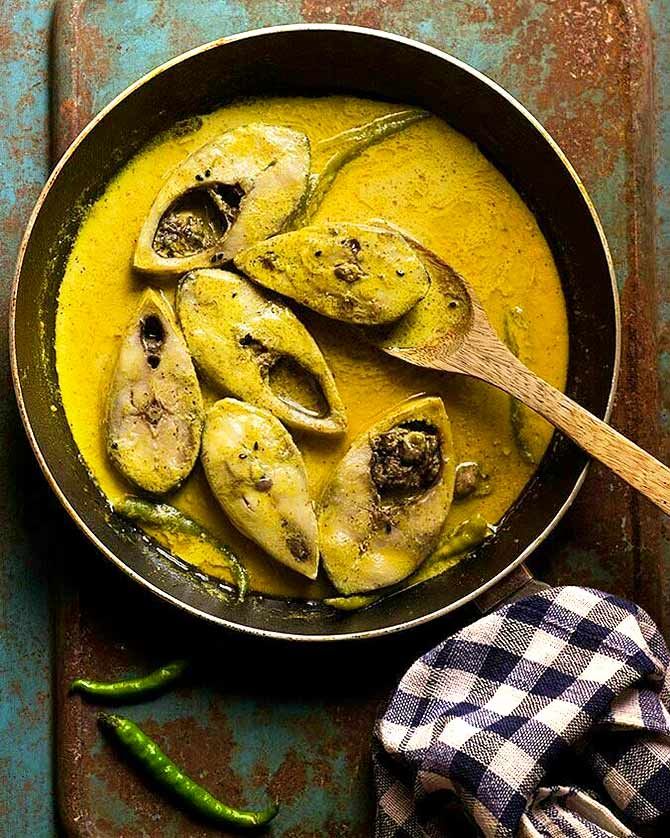
Photograph: Kind courtesy @cholrasta/Instagram
The monsoon is so associated with the dish, called hilsa by the British, that Bengalis have given the name ilshe guri to the lacy mist of rain which replaces the heavy downpour of the first month, ilshe being the adjectival derivative of ilish and guri meaning grain or powder.
The hilsa's life-cycle is something like that of the salmon.
After starting life in the sea, the fish comes to spawn in the estuarine waters where the rivers meet the Bay of Bengal, and slowly moves upstream into northern India, growing in size up to 2.5 kg (5½ lbs).
Many of the hilsa caught during the monsoon are big with roe, which is a delicacy in its own right and considered a caviar of the tropics…
All the differences between Ghotis and Bangals, between Hindus and Muslims, disappear in an agreement of amity -- that there is nothing to rival the hilsa.
Friendly disputes arise again over which is the superior: The hilsa from the Ganga by which the West Bengalis swear, or the hilsa from the Padma over which Bangladesh drools.
Padma specimens can be much bigger than those from the Ganga, though in terms of flavour and softness of texture, according to the proportion of oil in the fish, the Ganga variety is the superior of the two to my mind, but perhaps that is my Ghoti bias.
Expatriate Bengalis in the West have tried various fish in their desperate nostalgia for the hilsa, and the one that most of them think comes closest to their unique fish is the shad.
In shape and size it is certainly a fair equivalent, but the flavour and taste of the hilsa are unique.
For the real pleasure of eating this 'darling of the waters', as a Bengali poet called it, you have to come to Bengal, East or West.
When you do, you must be prepared to eat with your fingers, for the hilsa's treacherous bones can lodge themselves in the throat of the unwary.
I once heard an American in Dhaka compare Bengali women to the hilsa: 'Very tempting on the outside, but try to get close and you choke on the bones'. His comment prompted me to reflect that some people deserve their bones...
There are recipes enough for the hilsa to fill an entire book. Individuals, families and regions have all developed their special styles, spices and combinations for this delightful fish.
Here I will mention only a few that are my favourites and also very easy to make. All of them can be tried in the West with various hilsa substitutes: Shad, salmon and even herring.
Though the mackerel is also a soft and oily fish, somehow I do not find it satisfying in a Bengali recipe.
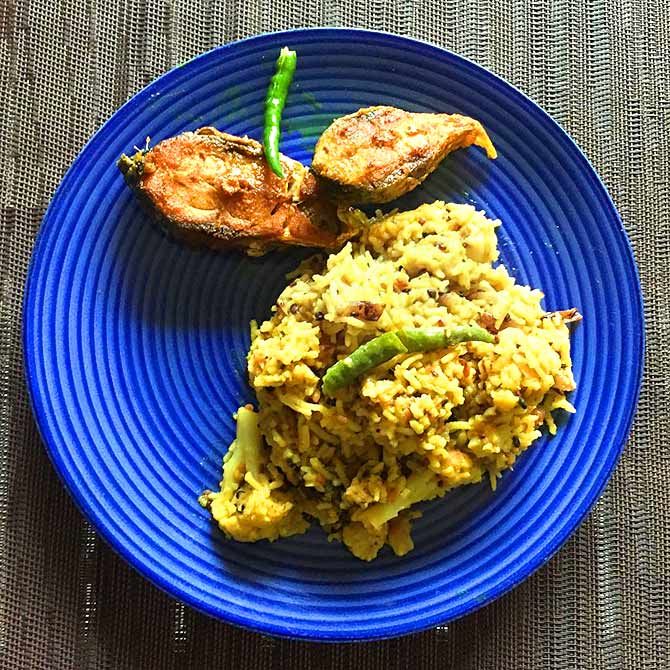
Photograph: Kind courtesy @thefinelychopped/Instagram
The simplest and one of the best ways to have hilsa is to fry it.
Once the pieces are washed and cleaned, they are dusted with some salt and powdered turmeric and left for a few minutes before being fried to a rich, deep brown in mustard oil.
A good hilsa will release almost 120 ml (4 fl oz) of oil in the process of frying.
Herring fried in this way is particularly good, though it may not yield as much oil.
Bengalis treasure the hilsa oil, pouring it over piping hot servings of rice and mixing it in thoroughly so that the fish can be eaten with this reinforced flavour.
All you need to accompany this is a pinch of salt on the side and one or more green chillies, according to your taste for hot food, from which you take the occasional bite.
If, however, you are serving the fish with khichuri, or if there are lots of other items for which you want to save the rice, then you store the fish oil carefully, for it is an invaluable flavouring agent for vegetables, especially those cooked together with the hilsa head.
The one I liked best was puishak, the slightly slippery-textured greens which miraculously absorbed and enhanced the hilsa flavour.
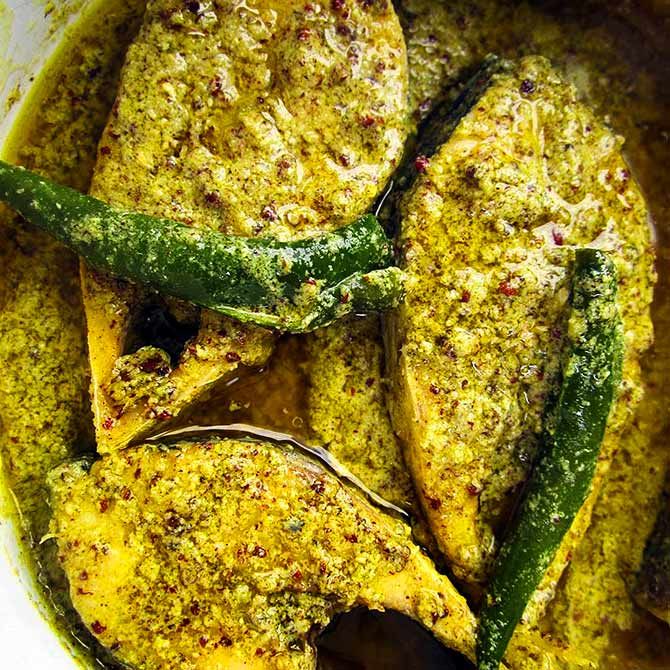
Photograph: Kind courtesy @foodrecipes.cuisine.culture/Instagram
Another classic Bengali preparation for the hilsa Shorshe Ilish is simple and depends on a single predominant taste, that of mustard.
For Shorshe Ilish (or hilsa with mustard) for four people, you need 500 g (1 lb) of peti pieces. A big fish will give you eight or nine pieces.
These should be washed and cleaned thoroughly.
Grind 1½ tablespoons of pungent black mustard seeds with a touch of salt and a green chilli. This will dispel the bitterness of the mustard.
Indian shops in the West always sell this mustard, and it is worthwhile going to the trouble of buying it, for white or brown mustard is no acceptable substitute.
The whole point of the dish is its pungency, which complements the rich oiliness of the fish. Mustard seeds can be ground in a blender, though not as finely as on a grinding stone.
Take 7 to 8 green chillies (or 2 to 3 if you cannot tolerate too much) and slit them down the middle.
Rub the pieces of fish with salt and turmeric.
Heat 4 tablespoons of mustard oil in a karai and add the mustard paste together with ½ teaspoon of turmeric powder.
Stir for a couple of minutes and add 250 ml (8 fl oz) of water.
As soon as it comes to the boil, gently put in the hilsa pieces and the green chillies.
Cover and cook for 10 minutes over a medium flame.
Uncover and taste to determine how much extra salt is needed.
The water should evaporate sufficiently to leave the fish coated in a thick, grainy, yellow sauce when you remove it.
If you want a thinner sauce, you can add some more water.
Remove from the stove and add a little fresh mustard oil to the fish. Leave covered for a few minutes.
When you serve it with plain boiled rice the sharp taste of the mustard will hit the palate.
The important thing to remember, I find, is not to overcook the fish.
The stomach pieces, in particular, are very soft and oily, and too much heat will destroy the texture, if not the flavour.
As with most Bengali dishes, there is always room for experiment and adjustments.
Some people prefer more of the mustard paste than others, while some love to drown their fish in mustard oil.

Photograph: Kind courtesy @gastronomad_m/Instagram
A similar way of preparing the fish -- more common in East than in West Bengal -- is called a paturi from the word pata, which is Bengali for leaf.
For this Iilish Paturi, take the pieces of fish, clean them and mix them thoroughly with salt, turmeric, the ground mustard, green chillies and a liberal helping of mustard oil.
The whole mixture is then wrapped in banana leaves and the packet tied with string before it is thrust among the dying embers of a clay oven, or toasted on a tawa or flat pan over a low heat.
The packet is turned over several times. By the time the top layer of leaf is burnt black, the fish should be ready.
The process can also be duplicated in an oven set at 150°C (330°F, gas mark 1).
In the absence of banana leaves, aluminium foil can be used.
Once the fish is cooked, it should be removed from the wrappings and all the sauce scraped out with a spoon.
The moisture and oil from the fish combined with the mustard paste and oil will produce quite a bit of sauce.
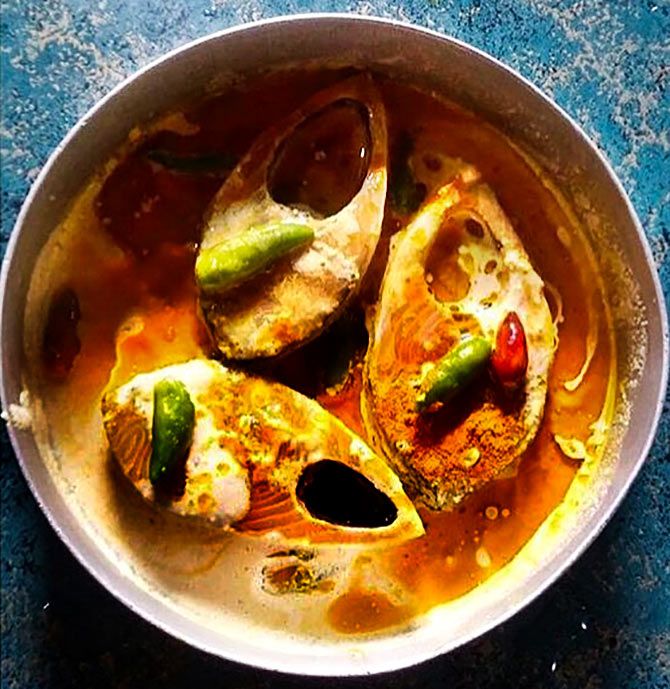
Representational photograph: Kind courtesy @theorangebowls/Instagram
During my childhood and college years in Calcutta, I had heard my relatives speak of the 'strange' ways the East Bengalis sometimes treated their hilsa, but I had never encountered any recipes that seemed particularly outré.
It was only after I went to live in Bangladesh that I came across some of the less usual forms of preparing hilsa.
A cook I hired in Dhaka, who came from the Bangladesh district of Mymensingh, was the first person to serve me hilsa with coconut milk.
Though Saba, the cook, had the maniacal appearance of true genius, and had already proved his worth in the kitchen, even I was at first a bit sceptical about how this dish was going to turn out.
The daring idea (or so it seemed to my timid West Bengali mind) of combining unlikely items like onions and ghee with hilsa (fish is always cooked in mustard oil, and Ghotis never use onion with hilsa) seemed to me fraught with disastrous possibilities.
But Saba had already demonstrated his mastery of unusual combinations, and so I allowed him to experiment with a plump and expensive hilsa.
When I finally served the dish, I was charmed by the novelty and richness of the taste.
To make hilsa with coconut milk for four people, you need 500 g (1 lb) of hilsa peti. The daga can also be used, but since the fish will not be fried, it will be harder to pick the bones out of the soft flesh.
You also require: 1 lemon; a whole coconut from which to extract milk, or you can substitute tinned coconut milk imported from Southeast Asian countries into the West, the quantity needed being 250 ml (8 fl oz); 7 to 8 medium onions; a 4 cm (1½ in) piece of ginger; 4 to 5 green chillies; 2 dry red chillies; 120 ml (4 fl oz) of ghee; garom mashla consisting of 3 sticks of cinnamon and 4 whole cardamoms; salt to taste.
Wash the pieces of hilsa, but do not add salt or turmeric.
Extract the milk from the coconut by cutting out pieces from the shell, grinding them in a blender, mixing it with some hot water and squeezing out and discarding the fibre.
You will need 250 ml (8 fl oz) of thick milk for the fish.
Peel 2 of the onions and the piece of ginger and grind them to a paste with the red chillies. You can use only one chilli if you want.
Squeeze all the juice out of the lemon into a bowl.
Heat the ghee in a karai and add the garom mashla.
After a couple of minutes, add the chopped onions and the green chillies.
Fry till the mixture becomes reddish brown and add the ground onion and ginger and 2 teaspoons of salt.
Add a quarter of the coconut milk and fry a little longer.
When the contents start sticking to the pot, pour in the rest of the coconut milk and add the pieces of hilsa.
Reduce the heat to low and simmer covered for 12 to 15 minutes.
Uncover to see if the fish is done and the salt is right. You may need to add some more.
Pour in the lemon juice, stir gently and remove from the stove.
This dish tastes much better with fine atap rice than parboiled rice.
Wedges of lemon may also be served so that each person can adjust the tartness to his own taste.
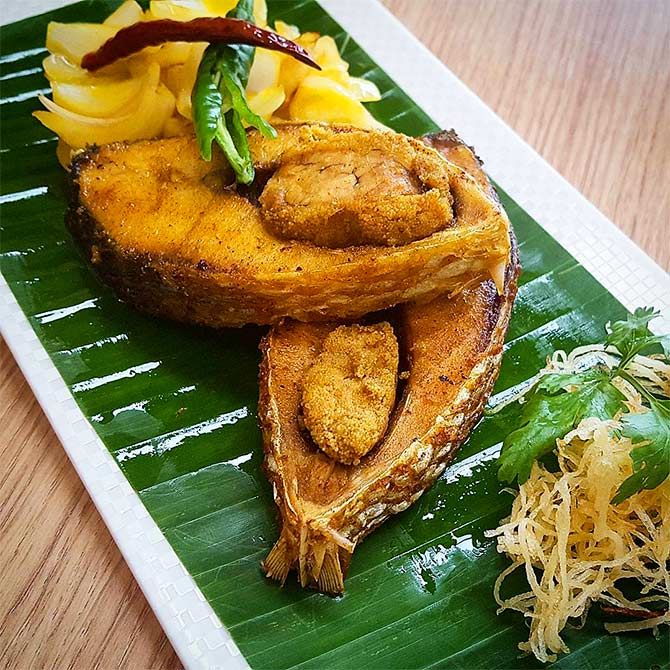
Photograph: Kind courtesy @poutpretty/Instagram
Bangladesh also has its own recipes for hilsa roe.
There I have seen the uncooked roe being put in a bowl and mashed thoroughly with a spoon or fork.
The membrane disintegrates and is discarded and the granulated substance of the roe is seasoned with salt, turmeric and a little chilli paste or powder.
One large potato is then peeled and chopped into tiny cubes and browned in mustard oil with a finely chopped large onion.
Then the seasoned roe is added together with several slit green chillies.
The entire mixture is stirred thoroughly until it turns into a brown-mustard grainy mass with the potatoes showing as tiny lumps.
This increases the quantity of roe, which can become a side-dish for a family of four or five.
My feudal friend from Tangail, Farhad Ghuznavi, also described the preparation made in his village by combining the hilsa roe with karamcha, a very sour local berry which has a semi-magical status, for a rural Bengali rhyme invokes karamcha with the leaves of lime trees as the potent combination for driving away rain.
A Bengali family can sometimes make an entire meal out of the different preparations of hilsa during the monsoon and find nothing strange about it.
Sometimes we start with a chhanchra of hilsa head with green leafy vegetables served with the initial helping of rice.
Then we take a fresh supply of hot rice, pour hilsa oil over it and have pieces of fried hilsa daga.
This will be followed by the fried roe portioned out between family members.
The peti, cooked in a pungent mustard sauce, will be the piece de resistance that finishes the meal.
Alternatively, one can start by pouring the hilsa oil over the rice and eating portions of the roe with it.
This may be followed by a thin hilsa jhol with aubergines and potatoes, after which the richer taste of hilsa peti with coconut milk will taste wonderful.
Excerpted from Chitrita Banerji's Bengali Cooking: Seasons & Festivals with permission from the publisher, Aleph Book Company. (This book was first published in 1991 as Life and Food in Bengal.)










